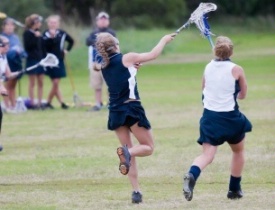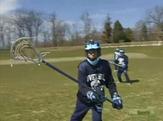How to Play Girls’ Lacrosse Defense Effectively

Playing defense in girls' lax has its challenges
By Anthony Coleman
PlaySportsTV.com Contributor
Girls’ lacrosse coach Brooke Crawford Record has a positive attitude when it comes to teaching players how to play defense. Defense in girls’ lacrosse is a difficult proposition because the offensive players have a great advantage. The slightest mistake by the defender in the offensive zone can lead to a score or an eight-meter free position shot on the goalie.
“It is difficult playing defense in lacrosse, but it’s not impossible,” says Record, head coach of the highly regarded Academy of Notre Dame (Pa.) girls’ lacrosse program.
“With the players we have, we tell them good defense starts with good footwork and body positioning and is not necessarily all about your stick and trying to strip the ball from the attacker. I think that is the wrong way to look at it. I think if you get good defensive positioning and you force them in a certain direction, one, the offensive player can take a bad shot or, two, wind up dropping the ball whether it is with good defense or a good double-team or will distribute (the ball) to somebody else who may or may not maintain possession. I think good defense starts with not good 1 v. 1 defense, but limits the attacker in what she can or cannot do.”
Record gets joy out of coaching lacrosse defense. Here's a great PSTV training video on checking in girls' lacrosse.
“Probably my favorite play to see is when someone is able to take a charge,” she says. “To me, that is sometimes even better than a great goal. Nothing is more exciting than causing a turnover. It’s harder to do. In high school lacrosse, there are about 15 goals in a game. To take a charge is a lot harder.
“To get a good double-team and come up with the ball, that doesn’t happen too often. That can be the spark that ignites a team. That allows the offense to have possession of the ball and score. To me, that is very exciting and very necessary. They say defense wins championships; that holds true in lacrosse.”
Girls’ Lacrosse Defense: To Check or Not to Check?
Whether to teach checking is perhaps the biggest decision a coach faces with defensive instruction. Trying to check the ball is the easiest way to commit a violation and leads to a free-position shot (thus placing extra pressure on the lacrosse goalie). Slashing or shots to the head are often the result, so it takes very skilled players to pull off the move legally.
“In terms of a philosophy, I don’t encourage my players to go for checks,” Record says. “Like I said, it starts with foundational footwork. You can use your stick to dictate and, if the check presents itself, to take the check but not committing body weight with that.”
Record has a warning for coaches who teach checking as a main defensive philosophy.
“(Officials) do call it a lot tighter (in high school lacrosse) than the college game,” she says. “In the college game, you are allowed some physical play whereas in the high school game, they are quick to call it if the stick goes horizontal and if there is any swinging involved, whether it’s over the head or too close to the face.”
Girls’ Lacrosse Defense: Dictate Attacking Movement
Record teaches “dictate attacking movement.” She believes the defender will have the advantage if she dictates the attacker’s movement instead of reacting to the attacker. For example, if the attacker’s dominant side is her right-handed shot, the defender will force her to the left. This will allow the weak-side help, slide or double-team to come from the defender’s right while keeping the ball on the attacker’s weaker left-handed side.
“If you can step up and force the attacker in a direction, dictate on the 1 v. 1 and dictate on the cutter, I think (the defense) feels a little more – not ownership – but feel more confident in their play,” she says. “They are able to control the attacking movement.”
Girls’ Lacrosse Defense: Hold the Rope
While one-on-one defense is key, Record coaches team defense. Her lacrosse players rely heavily on double-teams, slides, help and perhaps a second slide.
“You cover for one another,” she says. “We have a philosophy that we use called `hold the rope.’ Everybody holds the rope for one another. I think it is very applicable defensively, because you are there to cover. If one person gets beat, somebody else can slide – a better terminology might be `help’ – that defender.”
Obviously, 1 v. 1, 2 v. 2 and 3 v. 3 lacrosse drills are the best way to work on defense. In 2 v. 2 and 3 v. 3, the defenders have to work together. In 3 v. 3, the second defender is the help, while the third is the slide. At the same time, the initial defender is trying to dictate the attacker’s movement.
Record also works with defenders on being tight with the attackers and cutters who are off the ball. She teaches “stick on stick” to make sure the defenders are tight enough, because, “if you give them a couple of inches, they are good at catching and scoring. Again, you want to be tight on that person so you take away their cut so you are taking away their strong side.”
###
For more great girls' lacrosse tips, check out PSTV's complete collection of girls' lacrosse videos.








